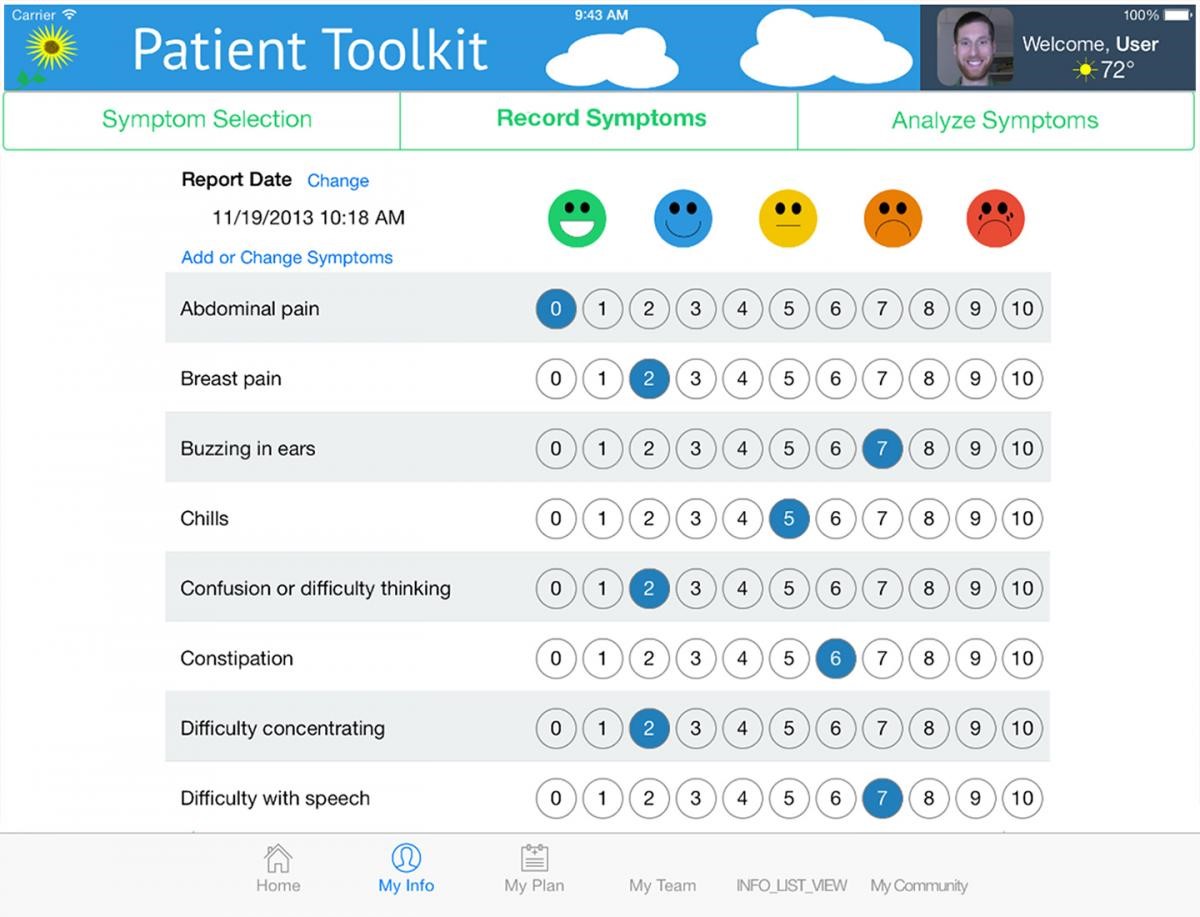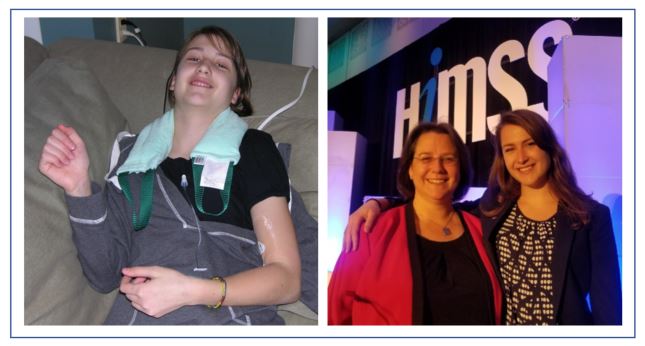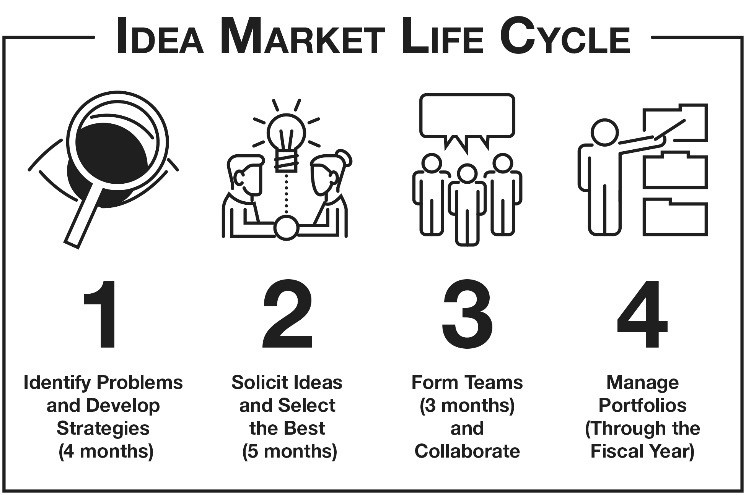Managing Innovative Ideas for Problems of National Importance

The Patient Toolkit is a mobile application that helps chronically ill patients and their caregivers better manage their illnesses.
Authors: Michal Cenkl and Marcie Zaharee
Organizations use innovation programs to develop new products and services for their customers. In MITRE’s case, our customers are government agencies that sponsor the seven federally funded research and development centers (FFRDCs) that MITRE operates. Our sponsors depend on MITRE to provide innovative solutions to some of our nation’s most critical challenges in defense and intelligence, aviation, system modernization, homeland security, cybersecurity, and healthcare. We tackle many of these challenges through the MITRE Innovation Program (MIP), our independent research and development (R&D) program, which supports researchers across the MITRE‑operated FFRDCs.
The Patient Toolkit, an iPad application, is an example of a new healthcare idea that progressed through the MIP to a licensable product administered by our Technology Transfer Office. Thanks to the MIP and a mother’s last-ditch effort to save her child from intense chronic pain, an iPad app is available to help other chronically ill patients. The Patient Toolkit is a mobile application that helps chronically ill patients and their caregivers better manage their illness. Patients track their own symptoms and medications daily and send the data with their iPad to their healthcare providers. Simple interfaces engage patients and help them develop good habits to improve their health outcomes.
Before joining MITRE, Kristina Sheridan’s daughter, Kate, got sick from Lyme Disease in 2006. Kate was treated but didn’t get better. After another year, Kate’s health degraded severely. She developed multiple comorbid, or secondary, conditions to the Lyme Disease. She went from a straight-A student to a special needs student; from reading three books at a time to not being able to read a single page. She went to a wheel chair. A constant 18-month pain level ran from 7-to-9 out of 10 in every joint in her body. She was totally dysfunctional and declining. Over three years, Kate went through a lot: she saw 30 different doctors, had five hospitalizations, received 15 diagnoses, and was prescribed multiple treatments and medications. The 30 doctors all had a piece of the story but only in their medical specialty field. With no view of the big picture, the doctors didn’t understand the impact of the chronic disease as comorbid (secondary) conditions to the underlying infection.
Looking at the problem differently
A year after joining MITRE, Sheridan looked at her child’s illness from a different perspective. She spent hours merging years of data about Kate’s illness into spread sheets, including the diagnoses from the 30 doctors. She mined the data to track trends: how her daughter’s white blood count fluctuated over time, how and when different doctors tried different treatments, for example. Sheridan found problems that Kate didn’t mention because she was used to the symptom—such as foot numbness when she saw a specialist. Kate had never mentioned more than 10 symptoms at any one appointment, but her mother identified a full set of 26. Sheridan used the data to develop visualizations for Kate’s pain and symptoms. That data, in combination with clinical data, finally unraveled the story for a new set of doctors in New York City. The doctors developed a new course of treatment and, after 18 months, Kate was back in school part-time. Today, she’s a thriving college student.

Kate Sheridan starting recovery from Lyme disease (left), and fully recovered with her mother, Kristina (right), at HIMSS-18, Las Vegas, NV, where she spoke about her recovery. See the live stream video of their session here.
Choosing the best ideas
As Kate was starting her recovery, Sheridan entered her process in the MITRE Innovation Program (MIP) our independent research and development program. The MIP is based on the Idea Market Life Cycle, a four-phase process for the fiscal year. The time required by MITRE for each phase follows (in parenthesis below), but may differ for other companies. The process is governed by a team of leaders representing the research program and direct work for our sponsors.
Phase 1: Identifying Problems and Developing Strategies (4 months)
Phase 2: Soliciting Ideas & Selecting the Best (5 months)
Phase 3: Forming Teams (3 months) and Collaborating
Phase 4: Managing Portfolios (through the fiscal year)

MITRE’s Technology Transfer Office helped Sheridan create a commercial license for the Patient Toolkit. Although she considered an Open Source license, the TTO felt that a commercial company would be more likely to continue to develop and maintain the technology in the future. One of the first licenses went to Gastro Girl, which has a telehealth platform for dietitians and health coaches who treat patients with chronic gastrointestinal symptoms and disorders.
Other commercial licensees for the Patient Toolkit include:
- Applied Medical Information, Inc.
- Patdat, LLC
- Blue Laurel, Inc.
Lessons Learned If your company is considering an innovation management system, consider six lessons that MITRE learned over the past few years:
- Know your problem space. An effective high-level strategy begins with understanding sponsors’ (customers’) needs. It helps you anticipate future conditions, assess gaps, and identify opportunities for shaping your research program.
- Establish and maintain process and infrastructure. Effective innovation offices require robust management processes with supporting tools to gather, evaluate and select ideas.
- Define a governance process that commits and prioritizes resources. A dedicated governance team, including your Chief Technology Officer, provides the framework for allocating strategic research funds aligned with corporate strategy.
- Communicate with employees throughout the innovation life cycle. An enterprise-level innovation management program has several stages: plan, execute, review, selection, and award. These stages span many months. You must keep stakeholders informed during each stage. Failing to communicate the status of the program leads to frustration and confusion.
- Measure results and impact. This includes tracking products and services brought to market. At MITRE, we track technology that’s licensed to sponsors and industry, patents received, as well as results shared through publication, standards bodies, and open source avenues.
- Capture and disseminate lessons learned. Documenting lessons learned is a powerful method of sharing ideas for improving work processes, day-to-day operations, and cost-effectiveness. This data improves management decision-making and supports team performance through every stage of the process.
A repeatable, structured process
An innovation management program that’s conducted openly and attracts participation from across the corporation will lead to innovations—from products or new policies. Our innovation management methodology and tools produce a repeatable, structured process that helps identify solutions to problems that have national scope and importance. The same methods and tools could help other organizations achieve similar benefits and results.
Note: For more information about the MITRE Innovation Program, see the technical paper, Managing Innovative Ideas for Problems of National Importance.
Michal Cenkl directs the Innovation Program for MITRE’s Center for Information and Technology, which is chartered with identifying and realizing disruptive and emerging technologies and practices into MITRE’s knowledge management and IT strategies and practices. He is responsible for MITRE’s Enterprise Technical Computing Initiative, applying enterprise-first principles to technical computing in support of data analytics. With MITRE for over 30 years, he applies emerging technologies to both internal and sponsor challenges.
Dr. Marcie Zaharee is the Innovation & Ideation Manager for MITRE’s Programs and Technology Group. She is responsible for the overall process, infrastructure, and information management of MITRE’s independent R&D program. Her experience includes human resources management, industrial security, knowledge management, intelligence analysis, systems engineering, and training & development. She has taught business courses at Western New England University and Webster University. She has also guest-lectured at Columbia University
A repeatable, structured process
An innovation management program that’s conducted openly and attracts participation from across the corporation will lead to innovations—from products or new policies. Our innovation management methodology and tools produce a repeatable, structured process that helps identify solutions to problems that have national scope and importance. The same methods and tools could help other organizations achieve similar benefits and results.
Note: For more information about the MITRE Innovation Program, see the technical paper, Managing Innovative Ideas for Problems of National Importance.
Michal Cenkl directs the Innovation Program for MITRE’s Center for Information and Technology, which is chartered with identifying and realizing disruptive and emerging technologies and practices into MITRE’s knowledge management and IT strategies and practices. He is responsible for MITRE’s Enterprise Technical Computing Initiative, applying enterprise-first principles to technical computing in support of data analytics. With MITRE for over 30 years, he applies emerging technologies to both internal and sponsor challenges.
Dr. Marcie Zaharee is the Innovation & Ideation Manager for MITRE’s Programs and Technology Group. She is responsible for the overall process, infrastructure, and information management of MITRE’s independent R&D program. Her experience includes human resources management, industrial security, knowledge management, intelligence analysis, systems engineering, and training & development. She has taught business courses at Western New England University and Webster University. She has also guest-lectured at Columbia University and currently teaches a Management & Leadership certificate program at Middlesex Community College. Dr. Zaharee holds degrees in Business Management (BS), Business Education (MS), and Computing Technology in Education (PhD).
© 2018 The MITRE Corporation. All rights reserved. Approved for public release. Distribution unlimited. Case number 18-1113
Solving problems for a safer world. The MITRE Corporation is a not-for-profit organization that operates research and development centers sponsored by the federal government. Learn more about MITRE.

0 Comments